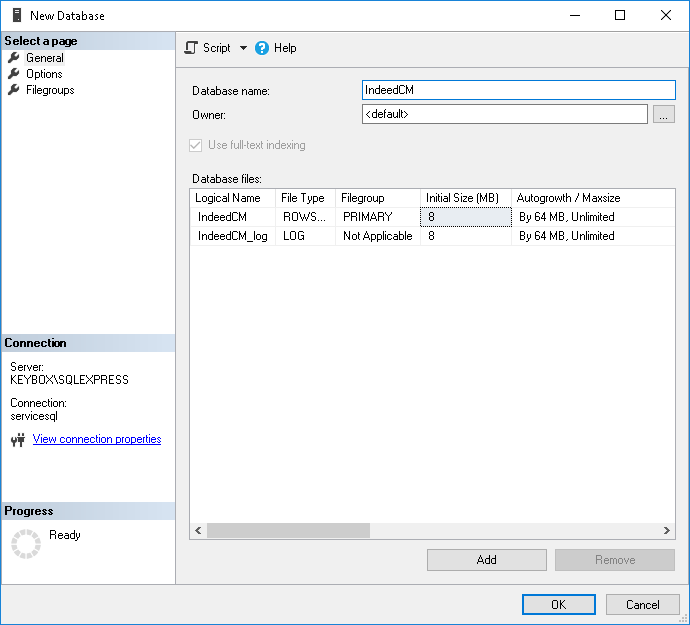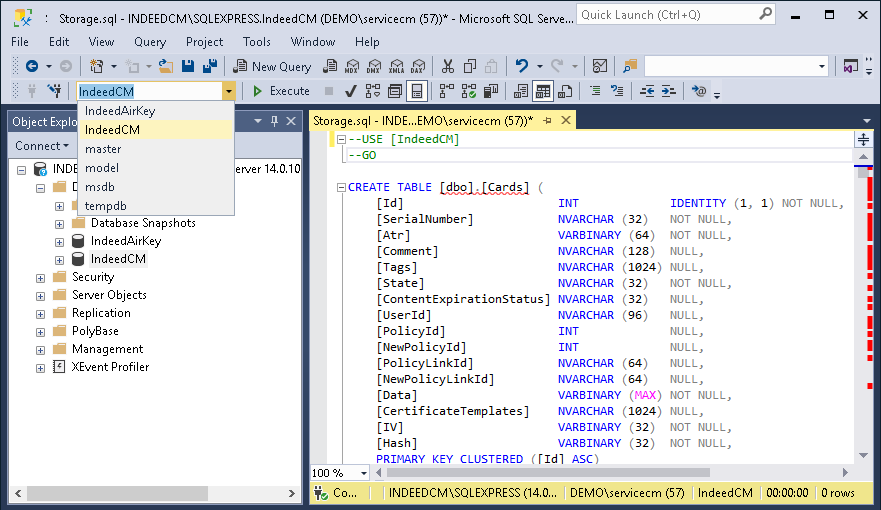Versions Compared
Key
- This line was added.
- This line was removed.
- Formatting was changed.
The Indeed Certificate Manager system database used as data storage is a database. The database is created manually and is populated using created manually. To populate the database, use the Storage.sql script from the Indeed CM included in the Axidian CertiFlow installation package (.. \IndeedCMCertiFlow.Server\Misc).
Data storage creationchange
Creating a database
1. Create a database in SQL Management
Studio environmentStudio environment with an arbitrary name
(say, IndeedCM):
To do this, in the- In Object Explorer, right-click on
- Databases tab
- .
- Select New Database.
- Specify the Database Name
- (e.g. CertiFlowDB) andclick OK
- .
 Image Modified
Image Modified
2. Use a local SQL account
or Windows domain account(for example,
servicecmcfServiceSQL) or Windows domain account and define
thepermissions for
the createdyour database. This account
shallwill be used to perform
reading data fromread and write operations to the database
and writing data to it. Connection of the. You can connect this account to the database
is carried out with Indeed CMin Axidian CertiFlow Setup Wizard.
- Define Logins for the created database (for example, servicecm):e.g. cfServiceSQL).
- Click Security > →Logins, select an account from the list.
- Go to the User Mapping tab and grant permissions .
- Grant permissions for the selected login to work with the database for the selected login, specify permissions: db_owner and public and click OK (Figure 3).
- Click OK.

3.
SelectSelect the created database
(IndeedCM)in
theObject Explorer and execute the Storage.sql script:
- Choose File
- →Open→File (or Ctrl+O), specify the path to
- Storage.sql file (located in
- ..\
- CertiFlow.Server\Misc
- change directory) and click Open.
- Before executing the script, uncomment: --USE [<database name>] --GO and specify the name of the database for which the script is applied (
- CertiFlowDB): --USE [
- CertiFlowDB] --GO. Or select the required database in the drop-down menu
- .
- Click Execute.
2. Use a local SQL account or Windows domain account (for example, servicecm) and define the permissions for the created database. This account shall be used to perform reading data from the database and writing data to it. Connection of the account to the database is carried out with Indeed CM Setup Wizard.
- Define the login name (e.g., IndeedCMSQL).
- Define the permissions for the database for the said login name as follows: db_owner, public (Figure 2):
Image Removed
Figure 2 – Microsoft SQL: permissions for working with database.
2. Open the created database in SQL Management Studio environment and execute the Storage.sql script:
- Select File – Open – File. . . menu, specify the path to Storage.sql (..\IndeedCM.Server\Misc\ folder of Indeed CM installation package) and click Open..
 Image Added
Image Added